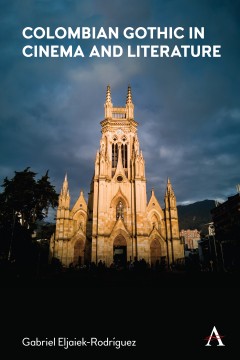Colombian Gothic in Cinema and Literature
By Gabriel Eljaiek-Rodriguez
Other Formats Available:
- About This Book
- Reviews
- Author Information
- Series
- Table of Contents
- Links
- Podcasts
About This Book
The Colombian Gothic in Cinema and Literature traces the aesthetic and political development of the Gothic genre in Colombia. Drawing on works like José Asunción Silva´s poetic “Nocturnos,” Caliwood’s films and Mario Mendoza’s novels, Gabriel Eljaiek-Rodriguez shows how Gothic tropes appear in the works of Colombian writers and filmmakers. However, he argues that what results ultimately is not just the Gothic in Colombia, but rather the Colombian Gothic—a new form of the genre with its own agenda and aesthetics.
To identify a form of the Gothic as “Colombian” is, in one sense, to demonstrate how thinkers from that nation have reconfigured and laid claim to tropes often regarded as the purview of Europe and the US. The Colombian Gothic pays homage to but also pokes fun at the Gothic of figures like Poe, Bronte, Hawthorne and Stoker. In the hands of Colombian writers and filmmakers, Gothic tropes are taken to their extremes to reflect particularly Colombian issues, like the ongoing armed conflict in the country since the 1950s as various left wing guerillas, government factions and paramilitary groups escalated violence. In this Colombian Gothic, traditional tropes like distorted familial relations appear as open fratricide and incest. Such transformations address the real-life horrors of violence wrought within the supposed protections of shared nationality.
In another sense, the Colombian Gothic does not just define itself apart from the US and European Gothics—it also challenges the centrality of Bogota-centered perspectives of Colombian politics and conflict. By the 1970s and 1980s, cities such as Cali suffered particularly extreme levels of violence, when the war among the drug cartels added another layer to the already complicated conflict. At the same time, Cali had one of the strongest filmmaking traditions in the country. The “Cali group” of writers and filmmakers seized the Gothic to challenge not just Europe and the US as the centers of the genre, but also to challenge Bogotá as the center of the country—and as the most “logical” place to set a Gothic narrative with its colder, gloomier, darker urban ambience. The Colombian Gothic of Cali addresses the topics of conflict, but within an unapologetically tropical setting that reflects the hotter climate in the region surrounding Cali. The effort of these Cali-based writers and filmmakers became so dominant in shaping the Colombian Gothic that the twenty-first-century Colombian Gothic—now mainly composed in Bogotá—follows the lead of these creators, continuing to create a Gothic that uniquely reflects the aesthetics and politics of Colombia.
Reviews
Though long obscured by the critical preoccupation with magical realism, the Gothic strain in Latin American literature has become a topic of vibrant scholarly interest in recent years. Gabriel Eljaiek-Rodríguez’s Colombian Gothic in Cinema and Literature is a welcome contribution to the field, charting, as it does, the emergence of a distinctive strain of Colombian Gothic in the nineteenth century and tracking its manifestations across literature and film of the twentieth and twenty-first centuries. As Eljaiek-Rodríguez’s pioneering study is at pains to show, the Colombian Gothic, while sharing certain affinities with the so-called Tropical Gothic, is as singular and distinctive as the culture and history that gave it form. For this reason alone, the book is crucial to understanding the global reach and significance of the Gothic in Central and South America, well beyond the more familiar Anglo-American frame. — Dale Townshend, Professor of Gothic Literature, Manchester Centre for Gothic Studies, Manchester Metropolitan University.
Eljaiek-Rodríguez’s short primer on the Colombian Gothic provides a helpful first point of contact for academics looking to understand the region’s unique engagement with this artistic tradition. It is also a welcome addition to critical debates on the Gothic’s transnational cultural work. — Dr Xavier Aldana Reyes, author of Spanish Gothic: National Identity, Collaboration and Cultural Adaptation (2017)
"This book is an innovative study of Colombian literature and film. It offers an in-depth focus on Colombian history as it looks at the ways in which the never ending (neo)colonization of the country creates new forms of monstrosity. An invaluable contribution to the growing field of Latin American and Caribbean Gothic studies." — Sandra Casanova-Vizcaíno, Assistant Professor, Binghamton University, State University of New York, US
From the tropical hot lands to the foggy and cold Andean valleys, Eljaiek-Rodríguez’s book is a groundbreaking revision of the presence of the Gothic in Colombia. It confirms the international appeal of this concept and, at the same time, explores its ability to adapt to particular geographical areas that highlight haunting social and political tensions in this South American country. — Enrique Ajuria Ibarra, Senior Assistant Professor, Universidad de las Américas Puebla, Mexico
Author Information
Gabriel Eljaiek-Rodríguez is a Colombian writer and academic currently teaching in Atlanta, Georgia. He has written extensively on the Latin American Gothic, Horror cinema and cultural migration.
Series
Anthem Studies in Gothic Literature
Table of Contents
Introduction: The Gothic in Colombia and in Latin America; 1. Gothic Pioneers: José Asunción Silva and José Joaquín Vargas Valdés; 2. Gothic in the “Hot Lands”; 3. Colombian Negrótico and the Gothic in the Mountains; 4. Beyond the Regions; Bibliography; Index.
Links
Stay Updated
Information
Latest Tweets



